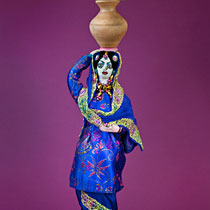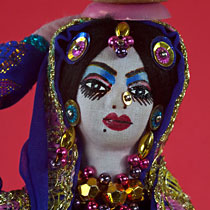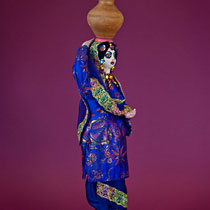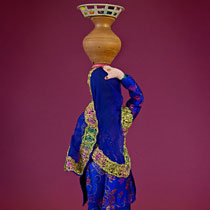Description of Figure/Doll
Pakistani lady, wearing a kameez of blue silk and lavender flowers. She is made with cloth. Her face is painted on the cloth, and her toenails and fingernails are also painted. Her veil (dupatta) is blue with embroidered edges. Her earrings and necklace are bright, colored beads. She has a sequin by her nose and also on her hair. There is a clay pot on her head. To learn more about the culture in Pakistan, read the story.
Link to higher resolution images at ClipPix
Pakistan
Location: Middle East
Capital: Islamabad
Main language: Urdu, English
Currency: Pakistani rupee
Figure/Doll
Construction: cloth
Height in Centimeters: 23
Height in Inches: 9

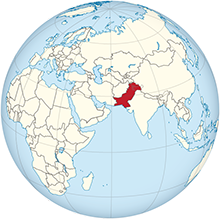
A Wedding in Pakistan
Reading Level: 6.20
The day was warm as I walked home from school. Many people were in the streets of Islamabad, which is the capital of Pakistan. I was born 13 years ago, and my country is only 40 years older than I am. Pakistan was once part of India, and it was controlled by England for many years. In 1947 it became the country of Pakistan. Our people are mostly Muslims, and Islam is our official religion. However, there is also a strong influence of the Indian Hindu culture in our society. English is still the official language of Pakistan, but the national language is Urdu. There are many regional languages as well.
Dress in the Muslim world is designed to cover the human body because nudity is prohibited in Islam. Most people wear a kameez, which is like a shirt with long splits on the sides. It can vary in length. Some have long sleeves and others have short sleeves. The shalwar is like loose trousers, and is worn under the kameez. Some women also wear a sari, which is a piece of cloth draped over their body.
Pakistani people are vey creative and love beautiful designs. Even the trucks and houses are often decorated in bright colors.
I really like going to school, and I know that I am lucky. Pakistan is a male-oriented society, and men have more opportunities than women. All families are headed by the male members, and boys are better educated than girls.
As I entered my house, my mind wandered towards the wedding plans of my 17 year old sister. You might be surprised to know that my sister’s husband was selected by my mother and father. This is another tradition from the Indian culture. I often wonder what sort of man my parents will select for me. I hope he is handsome and nice!
Everyone in my family is busy getting ready for the wedding. My grandmother and mother are cooking, and I can smell the curry and cumin aromas. My father is decorating the handmade vases for the flowers. My aunt is sewing the silk sari for the bride.
Our weddings have definite rituals. For example, the Mienu comes about four days before the ceremony. After this day, the groom will not see the bride until the day of the marriage. Both sides celebrate this occasion separately. The night before the wedding, the bride dyes her hands with henna. The groom’s family brings the wedding dress to her house, and the bride’s family delivers the groom’s wedding attire to his house. When the actual wedding day arrives, it is called a Shadi. Red clothing symbolizes this day. After the ceremony, dinner is served by the bride’s family. Later, the bride leaves her parent’s house to begin a new life with her husband.
Yes, Pakistan is a land of rich traditions. I can’t wait until the day when it is my wedding that is being planned.

